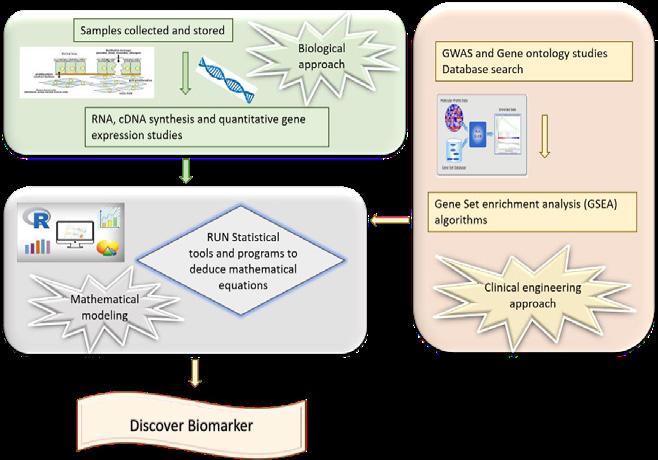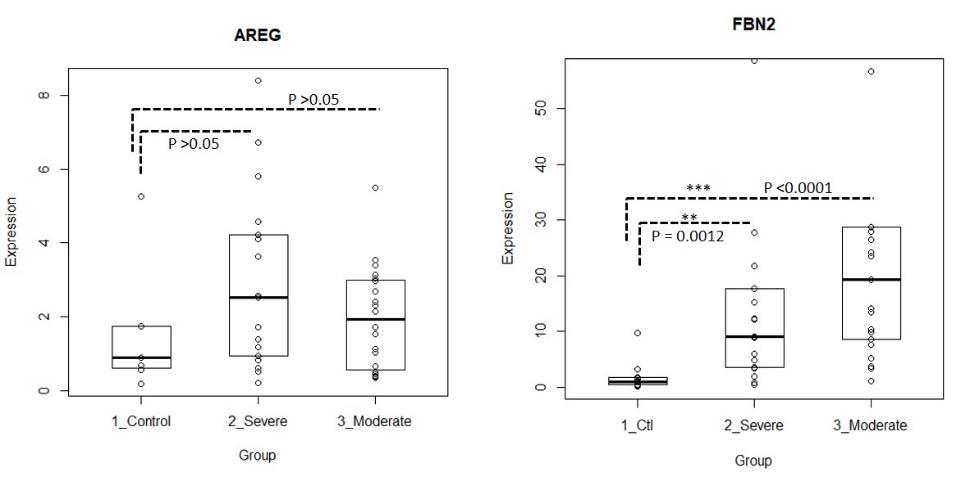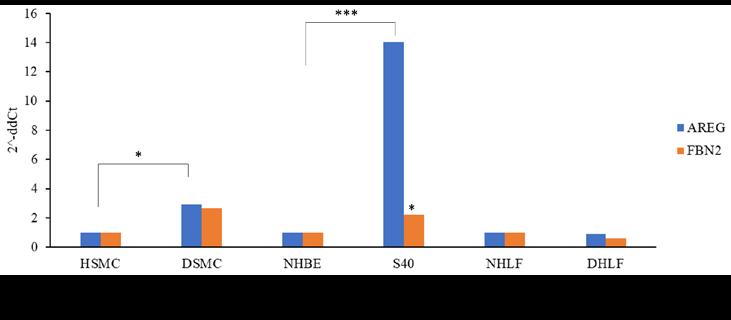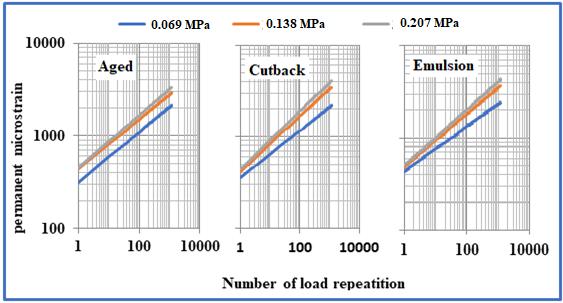
27 minute read
OMAINTEC JOURNAL OBJECTIVES
by Exicon
The magazine aims to be a distinctive platform through:
• Creating common ground of discussion among researchers, academics and Arab specialists in the operation and maintenance, facilities management and asset management sectors.
Advertisement
• Encouraging research in the operation and maintenance, facilities management and asset management sectors, and proper management of properties. The magazine will conduct research, scientific reviews or technical studies on the following topics in these sectors:
Operations and Maintenace Management
Transformation for Asset
Management
Maintenance
Performance Indicators
Safety Management Systems
KPI
Methodologies And definition
Asset Management Strategy planning in facilities & asset management
Total cost of ownership
Energy Management facilities
Management
Operations and Maintenace Standards
Environment
Management Systems
Health and safety polices
Assessment Of Recycled Asphalt Concrete Flexibility
Saad Issa Sarsam*1 Mohammed Chaloob Saleem 2
1 Professor, Department of Civil Engineering, University of Baghdad, Iraq *Corresponding author, email: saadisasarsam@coeng.uobaghdad.edu.iq
2Department of Civil Engineering, University of Baghdad, Iraq email: engsaad09@yahoo.com
Abstract
Utilizing reclaimed asphalt pavement (RAP) in new asphalt mixtures has increased in recent years because of its economic and environmental benefits. The flexibility of recycled asphalt concrete (with cutback and emulsion) in terms of resilient modulus (Mr), rutting resistance, and permanent microstrain have been investigated in this work. Cylindrical specimens of 102 mm in diameter and 102 mm in height have been prepared from the recycled mixture after the short -term aging process. Specimens were subjected to 1200 repeated compressive stresses at (25) ºC. The vertical permanent microstrain was monitored through video capture. It was concluded that RAP mixture can hold the applied loading with minimal permanent deformation as compared to the recycled mixtures . The resilient modulus is lower by (24 and 39) % for mixes recycled with cutback and emulsion respectively as compared to that of RAP. The rate of strain (slope) increases by 11 % and 4 % when cutback and emulsion were implemented as recycling agents respectively as compared to that for RAP mixture.
Keywords: Recycling; Asphalt Concrete; Rutting; Resilient Modulus; Permanent strain
1 Introduction
The challenge facing road engineers is to develop a sustainable asphalt mixture that reduces pavement system failure by developing new road materials and new methods of road construction and maintenance, [1]. Progress in road material science has focused on aged and waste materials, such as RAP, likely because of the continued availability of low-cost materials and due to the functional design of asphalt pavements. Recycling can provide the RAP, which is an important economical saving, RAP is usually considered to be a cost-effective pavement construction material that is placed in the pavement at increasing percentages, [2]. Many researchers had indicated the economic benefits of recycling, [3]. construction and reconstruction of road pavements imply a considerable consumption of valuable and non -renewable natural resources and the component materials of asphalt mixtures, [4]. The properties of the recycled mixture are believed to be mainly influenced by the aged, reclaimed asphalt pavement (RAP) binder properties, and the amount of RAP in the mixture, [5]. Asphalt binder loses many of its oil components during construction and service resulting in a high proportion of asphaltenes in the blend, wh ich leads to increased stiffness and viscosity of the binder and decreased ductility, making the binder hard and brittle, [6]. To recycle this hard and brittle aged pavement, the asphalt must be returned or changed to have the rheological properties of the original asphalt. This transformation is completed by adding liquid additives to the mixture being recycled, these additives have been called recycling agents or softening agents, [7]. Rejuvenating emulsions are normally used, containing oils that reduce the viscosity of aged asphalt cement, thus improving the adhesion and cohesion properties, as well as the flexibility of the binder. In addition, rejuvenators can penetrate the voids of the pavement, filling them and minimizing binder oxidation, [8]. The r utting resistance of recycled mixtures was studied by [9]. Four mixtures with RAP percentages of 0%, 15%, 30% and 50%, were tested. Results obtained from the wheel tracking test indicated that RAP mixtures have very similar rut depth values at the end of t he test when calculated between cycles 5000 and 10,000 which means that the presence of RAP in mixtures provides greater resistance to rutting. laboratory investigation of permanent deformation characteristics of asphalt concrete mixes containing reclaimed materials was presented by [10]. The permanent deformation characteristics of asphalt concrete with and without reclaimed materials were evaluated in the laboratory using the Repeated Load Axial Test and Wheel Tracking Test at a range of test temperatures. Test results showed that the asphalt concrete prepared using reclaimed materials such as waste plastic and Reclaimed Asphalt Pavement (RAP) was more resistant to permanent deformation over a range of temperatures. The use of resilient modulus testing to compare mixtures compacted with only virgin materials to those compacted with varying amounts of RAP was conducted by [11]. Resilient modulus testing was conducted in accordance with ASTM D 4123-82. The test was performed at 0.33, 0.5, and 1 Hz. In a 1 -Hz test, the applied cycles consisted of a 0.1-second load followed by a 0.9-second rest period. It was concluded that the resilient modulus rapidly decreases with increasing temperature. This is due to the softening of the asphalt binder as the temperature increases
In this investigation, the variation in the flexibility of the RAP and recycled asphalt concrete pavement (with cutback and emulsion) in terms of resilient modulus (Mr), rutting resistance, and permanent microstrain have been investigated.
2 Material Characteristics
2.1 Aged Materials
The reclaimed asphalt mixture was obtained by the rubblization of the binder course layer of asphalt concrete of the highway in the province of Babylon. This highway heavily deteriorated with various cracks and ruts existing on the surface. The reclaimed asphalt mixture obtained was assured to be free from deleterious substa nces and loam that gathered on the top surface. The reclaimed mixture was heated, combined , and reduced to testing size as per AASHTO, [12]; a representative sample was subjected to an Ignition test according to AASHTO T 308, [12] procedure to obtain binde r and filler content, gradation, and properties of aggregate. Table 1. Presents the properties of aged materials after the Ignition test.
Table 1. Properties of Aged Materials after Ignition Test
Gradation for the RAP obtained from the reclaimed mixture was determined; six samples have been selected randomly from the publication process of the material stack. These samples were subjected to an Ignition test to isolate binder from aggregate and then aggregate was sieved and separated to various sizes to calculate gradation for each sample. The differences between samples were to a minor extent, and the average gradation of the six samples obtained to be the old aggregate gradation is shown in Fig ure 1 which illustrates that the gradation of old (reclaimed) aggregate for the binder layer has slimly deviation with Specification limits of Roads and Bridge SCRB, [13].
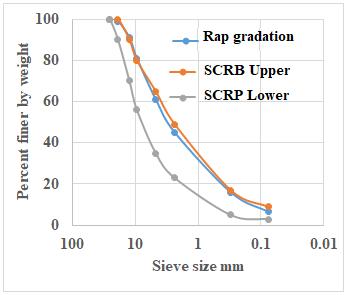
2.2
Two types of liquid asphalt have been implemented as recycling agents based on the available literature, [1, 4, 5, 6, and 14]. They are medium-curing cutbacks and cationic emulsions
Medium curing cutback (MC-30) obtained from the Al-Dura refinery was adopted for recycling in this work. The properties are listed in Table 2.
2.4
Cationic emulsion obtained from ministry of industry and minerals was adopted for recycling in this work, the properties are listed in Table 3.
2.5 Recycling of RAP Mixture
The recycled mixture consists of 100 % reclaimed pavement RAP and a recycling agent mixed together at specified percentages according to the mixing ratio. First, RAP was heated to approximately 160º C and liquid asphalt was added to the heated RAP at the desired amount of 0.5% by weight of the mixture and mixed for two minutes until all mixture was visually coated with recycling agent as addressed by [1]. The recycled mixture was prepared using two types of liquid asphalt: medium curing cutback and cationic emulsion.
2.6 Preparation of Accelerated Short-Term Aged Recycled Mixture
The recycled mixture was heated to 130°C to become loose and then diffuses in shallow trays with 3cm thickness and subjected to accelerated aging by laying inside an oven at 135°C for 4 hours as per the Superpave procedure, [12, and 16]. The mix was stirred every 30 m inutes during the short-term aging to prevent the outside of the mixture from aging more than the inner side because of increased air exposure.
2.7 Preparation of Asphalt Concrete Specimens
A cylindrical specimen of 102 mm in diameter and 102 mm in height has been prepared from the recycled mixture after the short-term aging process. The mold, spatula, and compaction hammer were heated on a hot plate to a temperature of 150º C. A piece of non -absorbent paper, cut to size, was placed in the bottom of the mo ld before the mixture was introduced. The asphalt mixture was placed in the preheated mold, and then it was spaded drastically with a heated spatula 15 times around the perimeter and 10 times around the interior. Another piece of non -absorbent paper cut to size was placed on top of the mix. The temperature of the mixture immediately prior to compaction temperature was 150ºC. The mold assembly was placed on the compaction pedestal and subjected to static compaction. The mixture was compressed at the top and bottom at a temperature of 150 °C under an initial load of 1Mpa to set the mixture versus the sides of the mold, after that the required load to achieve the target density of 2.372 gm/cm 3 was applied for two minutes and the specimen was left to cool at room temperature for 24 hours and then it was removed from the mold using the mechanical jack. Specimens were implemented for the Repeated compressive stresses test. Details of obtaining the target density were published elsewhere, [17]. Fig ure 2 exhibit part of the prepared cylindrical specimens.
2.8 Testing of the specimens under repeated compressive stresses
Asphalt concrete specimens were subjected to repeated compressive stresses in the pneumatic repeated load system PRLS. The axial repeated load was app lied to the specimen and the axial permanent deformation was measured. Compressive loading was applied in the form of a rectangular wave with a constant loading frequency of 60 cycles per minute and the loading sequence for each cycle is 0.1-sec load duration and 0.9 sec. Load repetitions were applied under constant three stress levels of (0.069, 0.138, and 0.207) MPa , while the testing temperatures of (25) ºC were implemented in the test. Figure 3 exhibit the repeated compressive stress setup. The permanent vertical strain is measured as a function of the number of load applications recognizing the fact that the lower permanent strain is related to the lower sensitivity for rutting and corrugation. The ac cumulation of permanent and resilient strains (εp and εr) was monitored directly through continuous video capture, while the resilient modulus (Mr) was calculated using equations 1 and 2, [16 and18]. Specimens have been tested under three stress levels.
(1) where: σ: repeated diametral stress (N/mm²) t: the thickness of specimen (mm).
P: applied load (N) h: specimen diameter (mm).
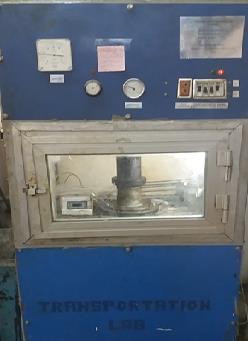
(2)
Where: σ: repeated diametral stress (N/mm²). εr: vertical resilient strain (mm/mm).
Mr: resilient modulus (N/mm²).
3 Results and Discussion
3.1 Effect of Recycling Agent Types and stress levels on Resilient Modulus (Mr)
Figure 4 exhibit the influence of the stress level on resilient modules for the aged and recycled mixture (cutback and emulsion) under compressive stress at 25 °C after 1200 load repetitions. The resilient modulus increases up to a stress level of 0.138 KPa, then decreases when the stress level increases to 0.207 MPa. The highest resilient modulus could be achieved at 0.138 MPa level of stress for all mixtures. This may be attribut ed to that the recycled mixture requirement of strength is suitable under the moderate traffic loading condition. A higher stress level of 0.207 MPa will possess extra tensile stresses which the mixture is unable to accommodate, then the resilient modulus is decreased. On the other hand, a lower stress level of 0.069 MPa will not exhibit a high impact on the resilient modulus. It can also be observed that the RAP mixture exhibits a resilient modulus of 171 MPa, while the recycled mixtures show lower resilient modulus by (24 and 39) % for mixes recycled with cutback and emulsion respectively as compared to that of the aged mixture. Such results agree with [16] work.
3.2 Effect of Recycling Agent Types and stress Levels on Resistance to Permanent Deformation under repeated compressive stress
Figure 5 shows the impact of stress level on the permanent deformation parameter of aged and recycled mixture with (cutback and emulsion) after 1200 load repetitions, it can be obser ved that while the stress level increases, the intercept value, and the slope increase as well for different mixtures. The rate of increase for RAP (aged) asphalt concrete is (37.5, and 45.3) % for 0.138 and 0.207 MPa stress levels as compared to that at 0 .069 MPa. For recycled mixture with (cutback), the rate of increases is (17, and 25) % as compared to that at 0.069 MPa.
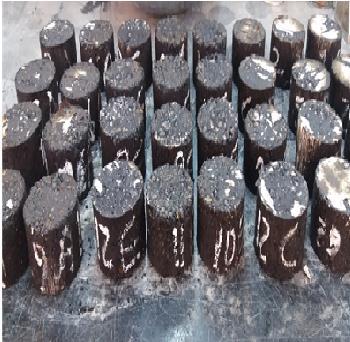
For recycled mixture with (emulsion), the rate of increases is (12, and 17) % as compared to that at 0.069 MPa. The rate of change in slope value is different for different stress levels and different mixtures. At a moderate stress level of 0.138 MPa, the recycled mixture with cutback asphalt shows a lower intercept value by 2 % as compared to that of RAP mixture, while the recycled mixture with emulsion exhibit a higher intercept value by 14 % as compared to an of RAP mixture. On the other hand, the rate of strain (slope) increases by 11 % and 4 % when cutback and emulsion were used as recycling agents respectively as compared to that for RAP mixture. this may be attributed to the more flexible nature of recycled asphalt concrete as compared to RAP. Such test results agree with [16 and 18] work.
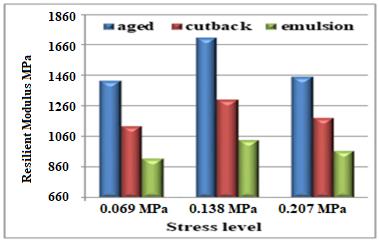
3.3
Figure 6 exhibits the rutting performance of various asphalt concrete mixtures; it can be observed that the stiffer RAP mixture can hold the applied loading with minimal permanent deformation as compared to the recycled mixtures. At a high-stress level of 207 kPa, the permanent strain increases by (20 and 28) % for recycled mixtures wit h cutback and emulsion respectively as compared to RAP mixture. Table 4 demonstrates the mathematical models regarding the resistance to rutting of asphalt concrete where (Y) represent the permanent deformation (microstrain) and (X) denotes the load repetitions. A similar rutting trend was reported by [14].
Concrete
4 Conclusions
Based on the testing program, the following conclusions could be drawn:
1- The resilient modulus is lower by (24 and 39) % for mixes recycled with cutback and emulsion respectively as compared to that of RAP (aged) mixture at a moderate stress level of 0.138 MPa.
2- The resilient modulus increases up to a stress level of 0.138 KPa, then decreases when the stress level increases to 0.207 MPa. The highest resilient modulus could be achieved at 0.138 MPa level of stress for all mixtures.
3- At a moderate stress level of 0.138 MPa, the recycled mixture with cutback asphalt shows a lower intercept value by 2 % as compared to that of RAP mixture, while the recycled mixture with emulsion exhibit a higher intercept value by 14 % as compared to to that of RAP mixture.
4- The rate of strain (slope) increases by 11 % and 4 % when cutback and emulsion were implemented as recycling agents respectively as compared to that for RAP mixture.
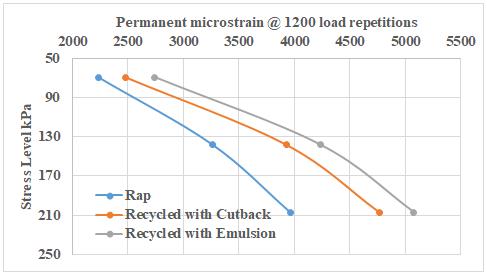
References
[1] Sarsam S. “A study of aging and recycling of Asphalt Concrete pavement. University of Sharjah ” , Journal of pure and applied Sciences, Sharjah UAE Vol.4 No.2 June- P79-94. (2007)
[2] B. Colbert, and You, Z., “The Determination of Mechanical Performance of Laboratory Produced Hot Mix Asphalt Mixtures Using Controlled RAP and Virgin Aggregate Size Fractions ” , Construction and Building Materials, Vol. 26, pp. 655- 662. (2012).
[3] NCHRP Synthesis 495. “Use of Reclaimed Asphalt Pavement and Recycled Asphalt Shingles in Asphalt Mixtures. A Synthesis of Highway Practice” National Cooperative Highway Research Program. Project 20-05, Topic, 46-05. (2016).
[4] I. Al-Qadi, E Seifi, M., and Carpenter, S., “Reclaimed Asphalt Pavement A Literature Review” , Report No. FHWAICT-07-001, Illinois Center for Transportation , Rantoul, IL. (2007)
[5] P. S. Kandhal, and Mallick R.B., “Pavement Recycling Guidelines for State and Local Governments Participant's Reference Book” , Report No. FHWA-SA-98-042, Federal Highway Administration Office of Engineering. (1997).
[6] A. Copeland, “Reclaimed Asphalt Pavement in Asphalt Mixtures: State of the Practice” , Report No. FHWA-HRT-11021, Report Date April (2011)
[7] H. M. Silva, Oliveira J.R.M., and Jesus, C.M.G., “Are totally recycled hot mix asphalts a sustainable alternative for road paving?” Resources, Conservation and Recycling , Vol. 60, PP. 38-48. (2012).
[8] K. A. O’Sullivan, “Rejuvenation of Reclaimed Asphalt Pavement (RAP) in Hot Mix Asphalt Recycling with High RAP Content” , M.Sc. thesis, Worcester Polytechnic Institute. (2011).
[9] R. Miro, Valdés, G., Martinez, A., Segura, P., Rodriguez, C. , “Evaluation of High Modulus Mixture Behavior with High Reclaimed Asphalt Pavement (RAP) Percentages for Sustainable Road Construction ” , Construction and Building Materials, Vol. 25, PP. 3854–3862. (2011).
[10] I. Aschuri, Woodward D. and Woodside A., “Permanent deformation characteristics of asphalt concrete containing reclaimed materials” , International Society for Maintenance and Rehabilitation of Transportation Infrastructure; technical report, Transportation Research Board. (2009).
[11] M. S. Sondag, Chadbourn, B.A., and Drescher, A., “Investigation of Recycled Asphalt Pavement (RAP) Mixtures ” , Report No. MN/RC – 2002-15, Minnesota Department of Transportation. (2002).
[12] AASHTO. “Standard Specification for Transportation Materials and Methods of Sampling and Testing” , American Association of State Highway and Transportation Officials , 14th Edition, Part II, Washington, D.C. (2013).
[13] SCRB, “General Specification for Roads and Bridges, Section R/9 Hot -Mix Asphalt Concrete Pavement”, Revised Edition, State Corporation of Roads and Bridges, Ministry of Housing and Construction , Republic of Iraq. (2003).
Fig. 6. Rutting Performance of Asphalt Concrete
4 Conclusions
Based on the testing program, the following conclusions could be drawn:
1- The resilient modulus is lower by (24 and 39) % for mixes recycled with cutback and emulsion respectively as compared to that of RAP (aged) mixture at a moderate stress level of 0.138 MPa.
2- The resilient modulus increases up to a stress level of 0.138 KPa, then decreases when the stress level increases to 0.207 MPa. The highest resilient modulus could be achieved at 0.138 MPa level of stress for all mixtures.
3- At a moderate stress level of 0.138 MPa, the recycled mixture with cutback asphalt shows a lower intercept value by 2 % as compared to that of RAP mixture, while the recycled mixture with emulsion exhibit a higher intercept value by 14 % as compared to to that of RAP mixture.
4- The rate of strain (slope) increases by 11 % and 4 % when cutback and emulsion were implemented as recycling agents respectively as compared to that for RAP mixture.
References
[1] Sarsam S. “A study of aging and recycling of Asphalt Concrete pavement. University of Sharjah ” , Journal of pure and applied Sciences, Sharjah UAE Vol.4 No.2 June- P79-94. (2007)
[2] B. Colbert, and You, Z., “The Determination of Mechanical Performance of Laboratory Produced Hot Mix Asphalt Mixtures Using Controlled RAP and Virgin Aggregate Size Fractions ” , Construction and Building Materials, Vol. 26, pp. 655- 662. (2012).
[3] NCHRP Synthesis 495. “Use of Reclaimed Asphalt Pavement and Recycled Asphalt Shingles in Asphalt Mixtures. A Synthesis of Highway Practice” National Cooperative Highway Research Program. Project 20-05, Topic, 46-05. (2016).
[4] I. Al-Qadi, E Seifi, M., and Carpenter, S., “Reclaimed Asphalt Pavement A Literature Review” , Report No. FHWAICT-07-001, Illinois Center for Transportation , Rantoul, IL. (2007)
[5] P. S. Kandhal, and Mallick R.B., “Pavement Recycling Guidelines for State and Local Governments Participant's Reference Book” , Report No. FHWA-SA-98-042, Federal Highway Administration Office of Engineering. (1997).
[6] A. Copeland, “Reclaimed Asphalt Pavement in Asphalt Mixtures: State of the Practice” , Report No. FHWA-HRT-11021, Report Date April (2011)
[7] H. M. Silva, Oliveira J.R.M., and Jesus, C.M.G., “Are totally recycled hot mix asphalts a sustainable alternative for road paving?” Resources, Conservation and Recycling , Vol. 60, PP. 38-48. (2012).
[8] K. A. O’Sullivan, “Rejuvenation of Reclaimed Asphalt Pavement (RAP) in Hot Mix Asphalt Recycling with High RAP Content” , M.Sc. thesis, Worcester Polytechnic Institute. (2011).
[9] R. Miro, Valdés, G., Martinez, A., Segura, P., Rodriguez, C. , “Evaluation of High Modulus Mixture Behavior with High Reclaimed Asphalt Pavement (RAP) Percentages for Sustainable Road Construction ” , Construction and Building Materials, Vol. 25, PP. 3854–3862. (2011).
[10] I. Aschuri, Woodward D. and Woodside A., “Permanent deformation characteristics of asphalt concrete containing reclaimed materials” , International Society for Maintenance and Rehabilitation of Transportation Infrastructure; technical report, Transportation Research Board. (2009).
[11] M. S. Sondag, Chadbourn, B.A., and Drescher, A., “Investigation of Recycled Asphalt Pavement (RAP) Mixtures ” , Report No. MN/RC – 2002-15, Minnesota Department of Transportation. (2002).
[12] AASHTO. “Standard Specification for Transportation Materials and Methods of Sampling and Testing” , American Association of State Highway and Transportation Officials , 14th Edition, Part II, Washington, D.C. (2013).
[13] SCRB, “General Specification for Roads and Bridges, Section R/9 Hot -Mix Asphalt Concrete Pavement”, Revised Edition, State Corporation of Roads and Bridges, Ministry of Housing and Construction , Republic of Iraq. (2003).
[14] S. I. Sarsam, AL-Zubaidi I. “Resistance to Deformation under Repeated Loading of Aged and Recycled Sustainable Pavement” American Journal of Civil and Structural Engineering , (AJCSE), Vol. 1(2), April Sciknow Publications Ltd. USA. p34-39. (2014).
[15] ASTM. “Road and Paving Material, Vehicle-Pavement System” . American Society for Testing and Materials. Annual Book of ASTM Standards, Vol.04.03 (2009).
[16] S. I. Sarsam and AL-Shujairy A. “Influence of recycling agent type on resilient modules and rutting resistance of asphalt concrete pavement” Applied Research Journal, ARJ . Vol.2, Issue, 1, January, pp.10 -18. (2016).
[17] M. C. Saleem “Influence of Liquid Asphalt Additives on the Properties of Recycled Asphalt Concrete ” MSc. Thesis, College of Engineering, University of Baghdad, (2018).
[18] S. I. Sarsam and AL-Janabi I. “Assessing Shear and Compressive Strength of Reclaimed Asp halt Concrete” International Journal of Scientific Research in Knowledge, (IJSRK) 2(8), pp. 352-361. (2014).
Linear Mathematical Modeling Identifies Amphiregulin And Fibrillin 2 As Differential Biomarkers For Severe Asthma
Poorna Manasa Bhamidimarri1, Bassam Mahboub3, Laila Salameh3, Mahmood Hachim4, Qutayba Hamid2, Rifat Hamoudi1,2
1Sharjah Research Academy, Sharjah, UAE
2College of Medicine, University of Sharjah, Sharjah, UAE
3 Department of Pulmonology, Rashid Hospital, Dubai, UAE
4 College of Medicine, Mohammed Bin Rashid University, Medicine and Health Sciences, Dubai, UAE
Corresponding author email: rhamoudi@sharjah.ac.ae
Abstract
Asthma has been classified into subtypes based on pathophysiological conditions, immunological markers, FEV1 , and FENO values. Nevertheless, there has been no single biomarker that can differentiate between different subtypes owing to its heterogenicity. These limitations urged to development of mathematical models to deduce specific differential biomarkers for various phenotypes of asthma with the help of a systems biology approach. The current study aims at understanding the differential mRNA biomarker for severe asthma and deduces a mathematical cutoff value to predict severity from healthy control in a non-invasive approach. Here, we report two salivary mRNA biomarkers, amphiregulin (AREG) and fibrillin 2 (FBN2) that can differentiate severe asthma patients from healthy control samples collected from UAE residents. The information from the hospital records and the mol ecular profiling in the laboratory facilitated to the discovery of the above biomarkers.
Key Words: biomarkers, mathematical modeling, severe asthma
Introduction
At present, asthma cannot be defined by a single condition but has generally been described as airway hyperresponsiveness and is often associated with allergies. Asthma can be broadly classified into Th2-associated and Non-Th2-associated inflammatory responses (Wenzel, 2012). Further classified into subtypes based on pathophysiological conditions, immunological response, the fraction of exhaled nitric oxide ( FENO), and forced expiratory volume in one second ( FEV1) levels(Agache et al., 2018). The complexity in determining asthma type also falls on various environmental factors like exacerbations, infections, pollutants, allergens, and other unidentified triggers. Hence, a similar treatment cannot be provided to all the subtypes. In order to p rovide successful treatment to the patients recruited by asthma conditions, it is important to identify a specific biomarker for every sub-phenotype that can be considered as a therapeutic target. In view of the heterogenicity, unidentified triggers, and varied immunological responses, there is a need for a mathematical approach to decode the complexity and arrive at a single specific biomarker from large datasets (Tang et al., 2020)
In the global context, the systems biology approach was used to analyze the big data available from the databases and hospital records to manage asthma in the respective local populations (Richards et al., 2018) Some of the biomarkers identified using genomics, transcriptomics, epigenetics, and other “omics” technologies have been reviewed by Tang et al and the importance of enlightening clinicians with systems biology tools was also emphasized (Tang et al., 2020). By using a similar approach, a model to predict type 2-high asthma with 100% positive predictive value was developed which was otherwise solely identified using conventional markers like serum IgE levels, eosinophilic count , and FENO levels but were not consistent in detection(Silkoff et al., 2017)
The present study was considered to apply system biology tools to detect severe asthma conditions among the UAE population with the help of linear mathematical modeling and omics technology. In UAE, approximately 8 -10% of adults were known to suffer from asthma(B. H. S. H. Mahboub et al., 2010). According to recent reports, this percentage is going to increase and it is the need of the hour to rightly distinguish severe asthma patients from mild/moderate asthmatics to improve the treatme nt prospects (B. H. Mahboub et al., 2012). Asthma can be cured if treated properly and a few earlier reports proved that specific treatments help patients to recover faster. The major challenge is to identify the appropriate biomarker and corresponding therapeutic target (Tiotiu, 2018). At the moment, the only method to overcome the problem is record keeping of the patient history, the right clinical classification, and analyzing the patient’s molecular profile by genomics, transcriptomics, and epigenetics and correlating all the parameters by machine learning tools (Vijverberg et al., 2013). By this approach, a specific biomarker for each subtype can be identified and a personalized treatmen t can be prescribed. The other important outcome of the study would be to identify markers that can predict the possibility of an individual developing severe asthma conditions in the future which helps clinicians to advise patients for any lifestyle-related modifications to avoid the disease development.
The reports from the laboratory earlier this year have established periostin (POSTN)(Hachim et al., 2020) and amphiregulin (AREG) (Hachim et al., 2020) as important biomarkers to differentiate non -severe and severe asthmatics from healthy control based on the studies on bronchial epithelial cells and ELISA method. The genome-wide association studies (GWAS) performed for specific populations worldwide in the context of asthma reported population-specific genes and possible mutations(Altman & Busse, 2017) From such studies, using image filtering algorithms and in -house developed pipelines, genes that differentially expressed for severe asthmatics were deduced (Hachim et al., 2019) These differentially expressed genes (DEG) were considered for the current study to identify specific mRNA biomarkers for severe asthma.
The major clinical manifestation of asthma is bronchi constriction which leads to difficulty in breathing. The tissue remodeling events occurring due to immunological response inside the airways and the modulatory effects of certain epidermal growth factors result in bronchi constriction (Enomoto et al., 2009). Hence, most of the studies related to asthma focus on tissue remodeling mechanisms. The major structural cell types that involve in tissue remodeling are epithelial cells, fibroblasts, and smooth muscle cells(Erle & Sheppard, 2014) In the present study, the primary cells obtained from the healthy controls and the asthmatic patients were compared for the differential biomarkers.
The unique aspect of the current investigation is to detect severe asthma-specific biomarker in saliva samples collected from asthmatics and control subjects living in UAE. Globally, studies conducted to identify asthma biomarkers largely focused on sputum, blood, bronchial brushings, and urine samples (Vijverberg et al., 2013). The salivary biomarkers for asthma known so far are proteins detected by ELISA. There are no mRNA salivary biomarkers reported to date. Therefore, the current study attempted to develop non-invasive mRNA biomarkers from saliva for severe asthma using molecular tools and mathematical modeling.
Methodology
Sample collection
Saliva from asthma patients and healthy controls were collected according to the previous protocol (Hachim et al., 2020). Ethical approval was granted for the present study under the reference number DSREC-11/2017_04 at the University of Sharjah. The samples were collected at Rashid Hospital, Dubai, UAE. The information about the patients and the parameters required for asthma regulation was recorded at the time of sample collection.
Cell culture
The primary cells obtained for the bronchial brushings of asthma patients and the healthy control subject were maintained at the tissue bank facility at Sharjah Institute of Medical Research (SIMR), College of Medicine, University of Sharjah. The specific culture medium required to maintain the cells was procured from Gibco, Thermo Fisher Scientific, US , and Sigma Aldrich, US. The primary human lung fibroblast cells for both healthy (NHLF) and asthmatic (DHLF) were obtained from Lonza, Switzerland. The smooth muscle cells and epithelial cells were obtained from the patient recruited in McGill University Health Centre/Meakins-Christie Laboratories Tissue Bank, Montreal, Canada
RNA isolation and cDNA synthesis
RNA from saliva samples was isolated by Qiazol m ethod as described in (Sullivan et al., 2020)Approximately, 500 ng of RNA was used to synthesize cDNA using high-capacity cDNA synthesis kit from Applied Biosystems.
RNA was isolated from cells using Trizol method and cDNA was synthesized as described a bove.
qRT PCR
The quantitative real-time PCR (qPCR) was performed for the cDNA obtained from both the saliva samples and the cells using primers for amphiregulin (AREG) and fibrillin 2 (FBN2) as listed in Table 2 The analysis was conducted in Quant Studio® 3 qPCR machine from Applied Biosystems.
Mathematical modeling method to determine the optimal value of the cutoff
The Index of Union method was applied to the data to determine the optimal cutoff value for the specific ge nes across the different groups (Unal, 2017). The method provides an “optimal” cut-point with the best maximum sensitivity and specificity values simultaneously and can be summarized by the following equation:
IU (c) = (|Se (c) AUC| + |Sp (c) AUC|) (1)
IU = Index of Union
AUC = Area Under Curve
Se = Sensitivity
Sp = Specificity
(c) = cutoff
IU(c) = the optimal cutoff point based on the Index of Union
Statistical analysis
Data obtained from the quantitative real-time PCR were analyzed by using an in-house R script and the P value was obtained using Mann Whitney U test between the groups.
Results and Discussion
Saliva sample collection and patient information
The whole saliva samples were collected from 10 healthy controls, 2 0 moderate asthma patients, and 18 severe asthmatics. The information regarding patient disease history and certain other characteristics was recorded using Salama Electronic Medical Record System launched by Dubai Health Authority (DHA).
From the records, patient history and characteristics were retrieved and were classified into moderate and severe asthma based on the FEV1 values, the number of asthma attacks, and hospitalization frequency (Table 1). Hence, it is important to maintain the clinical records with complete information and up to date.
Differential gene expression among the cell types
The major cell types known to involve in tissue remodeling are smooth muscle cells, epithelial cells , and fibroblasts. From the qPCR data, it is evident that AREG is highly expressed in asthmatic smooth muscle cells and epithelial cells. This data is consistent with the earlier known fact that AREG is upregulated in injured lung tissues and bronchial epithelial cells (Kuwano et al., 2017).
Similarly, FBN2 was upregulated in both the asthmatic smooth muscle cells and epithelial cells. Surprisingly, both genes showed no significant difference among the diseased fibroblast cells indicating their specific function in the preliminary ti ssue remodeling events.
Differential gene expression in saliva samples collected from the subgroups of asthma patients
Among the asthmatics, moderate/non-severe patients could be differentiated from the severe asthmatics based on the expression profile for AREG and FBN2 genes. Severe asthmatics showed highe r expression for AREG and lower for FBN2 as compared to moderate asthmatics. Both genes showed a significantly higher expression in asthmatics than in healthy controls indicating that they can be used as asthma biomarkers. In addition, the differential pat tern of expression among moderate and severe asthma can be exploited to differentiate the severity of the condition among the patient samples.
Determination of the cutoff value using the Index of Union mathematical method
Based on the Index of Union mathematical equations, an optimal cutoff value to differentiate severe from moderate asthmatics was deduced for both AREG and FBN2 genes in saliva. The fold change greater than 15 for FBN2 differentiates non -severe asthmatics from severe. And a fold chang e cut-off value 2 for AREG differentiates asthmatics from healthy controls. A combined profile for both AREG and FBN2 could be used to predict the severity of asthma among the patients.
Conclusion and future perspectives
From the study, a cutoff value was determined for two salivary mRNA biomarkers amphiregulin and fibrillin 2 using a linear mathematical model and the information from patient records to assess the severity of asthma in a non-invasive approach. The expression profile from the cells involved in tissue remodeling validated the mRNA biomarkers considered in the study. In the future, a similar study on larger datasets and robust mathematical modeling tools could help deduce a functional cutoff value that can be used to differentiate and predict s evere asthma samples from moderate asthmatics and prescribe personalized medication.
Funding
This research has been financially supported by Sharjah Research Academy (Grant code: MED001); the University of Sharjah (Grant code: 1901090254).
Reference
Agache, I., Strasser, D. S., Pierlot, G. M., Farine, H., Izuhara, K., & Akdis, C. A. (2018). Monitoring inflammatory heterogeneity with multiple biomarkers for multidimensional endotyping of asthma. Journal of Allergy and Clinical Immunology, 141(1), 442–445. https://doi.org/10.1016/j.jaci.2017.08.027
Altman, M., & Busse, W. W. (2017). A Deep Dive into Asthma Transcriptomics. American Journal of Respiratory and Critical Care Medicine, 195, 1279–1280.
Enomoto, Y., Orihara, K., Takamasu , T., Matsuda, A., Gon, Y., Saito, H., Ra, C., & Okayama, Y. (2009). Tissue remodeling induced by hypersecreted epidermal growth factor and amphiregulin in the airway after an acute asthma attack. Journal of Allergy and Clinical Immunology , 124(5), 913-920.e7. https://doi.org/10.1016/j.jaci.2009.08.044
Erle, D. J., & Sheppard, D. (2014). The cell biology of asthma. Journal of Cell Biology , 205(5), 621–631. https://doi.org/10.1083/jcb.201401050
Hachim, M. Y., Elemam, N. M., Ramakrishnan, R. K., Hachim, I. Y. , Salameh, L., Mahboub, B., al Heialy, S., Halwani, R., Hamoudi, R., & Hamid, Q. (2020). Confounding patient factors affecting the proper interpretation of the periostin level as a biomarker in asthma development. Journal of Asthma and Allergy , 13, 23–37. https://doi.org/10.2147/JAA.S230892
Hachim, M. Y., Mahboub, B., Hamid, Q., & Hamoudi, R. (2019). Identifying Asthma genetic signature patterns by mining Gene Expression BIG Datasets using Image Filtering Algorithms. IST 2019 - IEEE International Conference on Imaging Systems and Techniques, Proceedings , 1–6. https://doi.org/10.1109/IST48021.2019.9010412
Hachim MY, Elemam NM, Ramakrishnan R , Salameh L , Olivenstein R, Hachim I , Venkatachalam T, Mahboub B, Heialy S , Halwani R, H. Q. and H. R. (2020). Blood and Salivary Amphiregulin levels as biomarkers for Asthma. Frontiers Medicine, 10.3389/fm
Kuwano, K., Yanagihara, T., Hamada, N., Ikeda -Harada, C., Yokoyama, T., Suzuki, K., Kawaguchi, T., Maeyama, T., & Nakanishi, Y. (2017). Amphiregulin suppresses epit helial cell apoptosis in lipopolysaccharide -induced lung injury in mice. Biochemical and Biophysical Research Communications , 484(2), 422–428. https://doi.org/10.1016/j.bbrc.2017.01.142 asthma samples from moderate asthmatics and prescribe personalized medication.
Funding
This research has been financially supported by Sharjah Research Academy (Grant code: MED001); the University of Sharjah (Grant code: 1901090254).
Reference
Agache, I., Strasser, D. S., Pierlot, G. M., Farine, H., Izuhara, K., & Akdis, C. A. (2018). Monitoring inflammatory heterogeneity with multiple biomarkers for multidimensional endotyping of asthma. Journal of Allergy and Clinical Immunology, 141(1), 442–445. https://doi.org/10.1016/j.jaci.2017.08.027
Altman, M., & Busse, W. W. (2017). A Deep Dive into Asthma Transcriptomics. American Journal of Respiratory and Critical Care Medicine, 195, 1279–1280.
Enomoto, Y., Orihara, K., Takamasu , T., Matsuda, A., Gon, Y., Saito, H., Ra, C., & Okayama, Y. (2009). Tissue remodeling induced by hypersecreted epidermal growth factor and amphiregulin in the airway after an acute asthma attack. Journal of Allergy and Clinical Immunology , 124(5), 913-920.e7. https://doi.org/10.1016/j.jaci.2009.08.044
Erle, D. J., & Sheppard, D. (2014). The cell biology of asthma. Journal of Cell Biology , 205(5), 621–631. https://doi.org/10.1083/jcb.201401050
Hachim, M. Y., Elemam, N. M., Ramakrishnan, R. K., Hachim, I. Y. , Salameh, L., Mahboub, B., al Heialy, S., Halwani, R., Hamoudi, R., & Hamid, Q. (2020). Confounding patient factors affecting the proper interpretation of the periostin level as a biomarker in asthma development. Journal of Asthma and Allergy , 13, 23
37. https://doi.org/10.2147/JAA.S230892
Hachim, M. Y., Mahboub, B., Hamid, Q., & Hamoudi, R. (2019). Identifying Asthma genetic signature patterns by mining Gene Expression BIG Datasets using Image Filtering Algorithms. IST 2019 - IEEE International Conference on Imaging Systems and Techniques, Proceedings , 1–6. https://doi.org/10.1109/IST48021.2019.9010412
Hachim MY, Elemam NM, Ramakrishnan R , Salameh L , Olivenstein R, Hachim I , Venkatachalam T, Mahboub B, Heialy S , Halwani R, H. Q. and H. R. (2020). Blood and Salivary Amphiregulin levels as biomarkers for Asthma. Frontiers Medicine, 10.3389/fm
Kuwano, K., Yanagihara, T., Hamada, N., Ikeda -Harada, C., Yokoyama, T., Suzuki, K., Kawaguchi, T., Maeyama, T., & Nakanishi, Y. (2017). Amphiregulin suppresses epit helial cell apoptosis in lipopolysaccharide -induced lung injury in mice. Biochemical and Biophysical Research Communications , 484(2), 422–428. https://doi.org/10.1016/j.bbrc.2017.01.142
Mahboub, B. H., Al-Hammadi, S., Rafique, M., Sulaiman, N., Pawankar, R ., al Redha, A. I., & Mehta, A. C. (2012). Population prevalence of asthma and its determinants based on European Community Respiratory Health Survey in the United Arab Emirates. BMC Pulmonary Medicine, 12. https://doi.org/10.1186/1471-2466-12-4
Mahboub, B. H. S. H., Santhakumar, S., Soriano, J. B., & Pawankar, R. (2010). Asthma insights and reality in the United Arab Emirates. Annals of Thoracic Medicine, 5(4). https://doi.org/10.4103/1817-1737.69109
Richards, L. B., Neerincx, A. H., van Bragt, J. J. M. H. , Sterk, P. J., Bel, E. H. D., & Maitland -Van der Zee, A. H. (2018). Biomarkers and asthma management: Analysis and potential applications. Current Opinion in Allergy and Clinical Immunology, 18(2), 96–108. https://doi.org/10.1097/ACI.0000000000000426 https://doi.org/10.1016/j.jaci.2016.11.038 https://doi.org/10.1371/journal.pone.0229791 https://doi.org/10.1183/13993003.00844 -2019
Silkoff, P. E., Laviolette, M., Singh, D., FitzGerald, J. M., Kelsen, S., Backer, V., Porsbjerg, C. M., Girodet, P. -O., Berger, P., Kline, J. N., Chupp, G., Susulic, V. S., Barnathan, E. S., Baribaud, F., & Loza, M. J. (2017). Identification of airway mucosal type 2 inflammation by using clinical biomarkers in asthmatic patients. The Journal of Allergy and Clinical Immunology, 140(3), 710–719.
Sullivan, R., Heavey, S., Graham, D. G., Wellman, R., Khan, S., Thrumurthy, S., Simpson, B. S., Baker, T., Jevons, S., Ariza, J., Eneh, V., Pye, H., Luxton, H., Hamoudi, R., Whitaker, H., & Lovat, L. B. (2020). An optimised saliva collection method to produce high -yield, high-quality RNA for translational research. PLoS ONE, 15(3), 1–16.
Tang, H. H. F., Sly, P. D., Holt, P. G., Holt, K. E., & Inouye, M. (2020). Systems biology and big data in asthma and allergy : Recent discoveries and emerging challenges. European Respiratory Journal, 55(1).
Tiotiu, A. (2018). Biomarkers in asthma: state of the art. Asthma Research and Practice , 4(1), 1–10. https://doi.org/10.1186/s40733-018-0047-4
Unal, I. (2017). Defining an optimal cut -point value in ROC analysis: An alternative approach. Computational and Mathematical Methods in Medicine , 2017. https://doi.org/10.1155/2017/3762651
Vijverberg, S. J. H., Hilvering, B., Raaijmakers, J. A. M., Lammers, J. W. J., Maitland -van der Zee, A. H., & Koenderman, L. (2013). Clinical utility of asthma biomarkers: From bench to bedside. Biologics: Targets and Therapy , 7(1), 199
210. https://doi.org/10.2147/BTT.S29976
Wenzel, S. E. (2012). Asthma phenotypes: The evolution from clinical to molecular approaches. Nature Medicine, 18(5), 716
725. https://doi.org/10.1038/nm.2678

